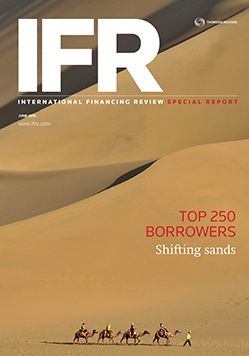Shifting sands – Credit markets posted yet another year of storming supply, a scene played out in an unnatural landscape constantly reshaped by shifting sands. On the one hand, the US called time on its quantitative easing bond-buying programme; but, on the other, the European Central Bank scrambled up the dunes to proclaim an initiative of its own. In the QE stakes, Frankfurt simply replaced Washington.
Funding conditions remain benign as the buyside and sell-side alike grapple with similar circumstances. While the former continues searching for incremental returns in low-yield shallow soil, the latter enjoys mixed fortunes, depending on which end of the ratings spectrum they are.
For higher beta borrowers, demand assumed significant proportions, the flip side of the coin being that some highly rated issuers looking to the euro market in particular found spreads and yields so compressed that they began to struggle to find willing buyers of their offerings.
Even before the ECB announced its well-flagged €1.1trn QE programme in January, things were moving apace in Europe.
Government bond yields then dropped to fresh lows, turning negative in a number of cases, and creating an element of confusion among investors historically programmed to minimise risk by buying the highest rated assets.
The situation on the other side of the Atlantic threw up a similar scenario, with rates not assuming the velocity of upward trajectory many had assumed.
Clearly, a fresh approach was required, and the best part of €180bn of corporate debt in the European market in the year to end-May demonstrated that buyers were not averse to broadening their horizons, given that it represented a 31% increase on the previous year.
And, naturally, the juicier the yield the better, as evidenced by a 50% increase in corporate hybrid issuance. Volumes in the high-yield market also rose in lock-step.
For investors, there was little alternative to a risk-on stance, something that could be taken as QE efficacy as money moved down the funding food chain.
But artificial situations are just that, and it was clear something had to give. A sandstorm ensued, with yield levels reversing from ultra-low to just low.
Nerves in bond markets that have revived fears of a crisis have been blamed by traders on liquidity distortions. Ample monetary liquidity coexists with a shortage of trading liquidity, constraining the market’s ability to absorb shocks and further exacerbating the risk of volatility.
One cause of liquidity problems is regulatory change to ensure lenders boost levels of risk-weighted assets. Since 2008 regulators have forced banks to pile capital up like grain in a silo, most recently through strictures about total-loss absorbing capacity on globally systemically important banks, or G-Sibs from the Basel-based Financial Stability Board. Compounding this is regulatory one-upmanship. Just 12 days after TLAC’s introduction, the Europeans again unveiled their own draft rules, MREL. Two sets of regulations, both building sandcastles.
Indeed, regulatory anxiety is everywhere. US authorities have grown jumpy about the use of covenant-lite leveraged loans, and China has been stacking up rules to tackle provincial debt, spawning a market in municipal bonds in conditions where a default seems likely.
The leveraged loan market demonstrates how, historically, the causal chain of volatility can so often be traced archeologically back to the US.
For example, leveraged buyouts – a homespun symbol of the pre-crisis boom – are back with a vengeance. Leveraged loans styled on those across the pond are now growing popular in Europe as bank lending loses its appeal and the region develops an appetite for takeovers.
The Europeans are also being lured by another American mirage, proposing a capital markets union to shift the burden of financing away from banks to DCM.
The financing of M&A through leveraged loans negotiated in centres such as Hong Kong is increasingly copying US architecture, and China’s muni market also attests to its taste for the American financial flavours that, like bubble gum, have gained such global appeal.
When the latest storm subsides and the dust settles, the landscape will look both reassuringly familiar – and yet eerily different.
To see the digital version of this report, please click here
To purchase printed copies or a PDF of this report, please email gloria.balbastro@thomsonreuters.com
<object id="__symantecPKIClientMessenger" style="display: none;"></object>
<object id="__symantecPKIClientMessenger" style="display: none;"></object>
